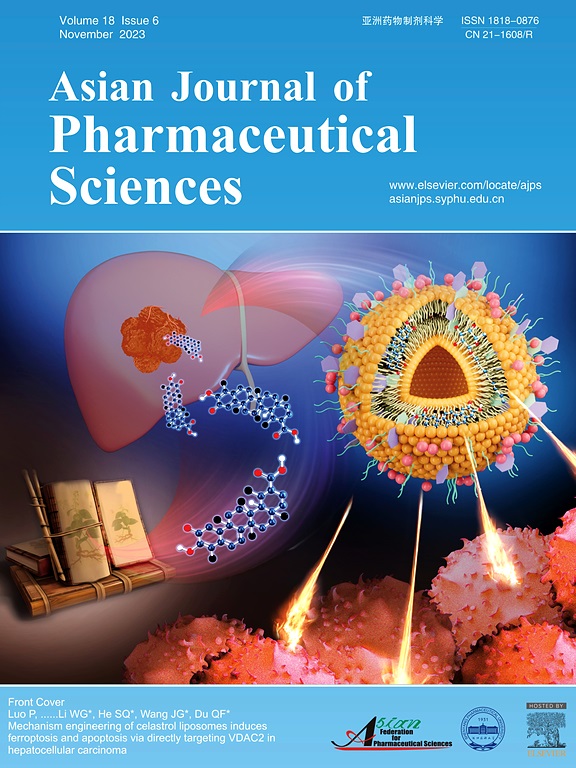通过HIF-1α-P-gp/脂解轴反转,CeO2纳米酶包埋热变形聚合物用于部位特异性化疗
IF 11.9
1区 医学
Q1 PHARMACOLOGY & PHARMACY
引用次数: 0
摘要
多柔比星(doxorubicin, DOX)在细胞内的有效蓄积对提高抗肿瘤疗效至关重要,但药物渗透有限、药物释放不可控和耐药严重阻碍了DOX的蓄积。本研究合理设计了一种热变形聚合物包埋超小二氧化铈(CeO2),用于肿瘤深部药物穿梭和缺氧逆转,以改善化疗。在结构上,CeO2纳米酶与p(NIPAM-co-AM)聚合物共价接枝,该聚合物可以在DOX负载下急剧收缩,并用聚多巴胺(PDA)薄膜封装巩固。随后,将载脂蛋白a -i (apoA-I)结合的iRGD肽(apoA-I-iRGD)的肿瘤穿透指南进一步通过Michael加成修饰到PDA外壳上,制备CeO2P/DOX@iAPDA。在apoA-I-iRGD的帮助下,CeO2P/DOX@iAPDA深入穿透肿瘤球体(~ 78µm)和小鼠模型的肿瘤。经肿瘤细胞内化和溶酶体低pH触发后,通过剥离PDA外壳和p(NIPAM-co-AM)的热敏变形实现DOX的快速释放。CeO2P/DOX@iAPDA分别对4t1源性肿瘤球体和4t1荷瘤小鼠的肿瘤抑制率分别为66.4 %和63.2 %。western blotting和免疫组化的初步机制研究显示CeO2P/DOX@iAPDA通过HIF-1α-P-gp/脂质轴逆转耐药。总的来说,这项研究智能地整合了CeO2纳米酶、温度敏感聚合物和模拟生化修饰,以改善乳腺癌的化疗。本文章由计算机程序翻译,如有差异,请以英文原文为准。

CeO2 nanozyme-embedded thermal-deformative polymer for site-specific chemotherapy via HIF-1α-P-gp/lipolysis axis reversal
The effective intracellular accumulation of doxorubicin (DOX) is crucial for improving antitumor efficacy, which is severely impeded by limited drug penetration, uncontrollable drug release, and drug resistance. In this study, a thermal-deformative polymer embedding ultrasmall ceria (CeO2) was rationally designed for deep tumor drug shuttling and hypoxia reversal to improve chemotherapy. Structurally, the CeO2 nanozyme was covalently grafted with a polymer of p(NIPAM-co-AM) that could sharply shrink for DOX loading, which was consolidated with polydopamine (PDA) film encapsulation. Thereafter, a tumor penetration guide of apolipoprotein A-I (apoA-I) conjugated iRGD peptide (apoA-I-iRGD) was further decorated onto the PDA shell via Michael addition for preparing CeO2P/DOX@iAPDA. With the aid of apoA-I-iRGD, CeO2P/DOX@iAPDA penetrated both the tumor spheroids (∼78 µm) and the tumors of the mouse model deeply. After internalization by tumor cells and triggering by low pH in lysosomes, rapid DOX release was achieved by peeling off the PDA shell and thermosensitive deformation of p(NIPAM-co-AM). CeO2P/DOX@iAPDA provided 66.4 % tumor suppression in 4T1-derived tumor spheroids and 63.2 % in 4T1-tumor-bearing mice, respectively. Preliminary mechanistic research involving western blotting and immunohistochemistry revealed that CeO2P/DOX@iAPDA reversed resistance through the through HIF-1α-P-gp/lipid axis. Collectively, this study intelligently integrated CeO2 nanozymes, temperature-sensitive polymers, and imitated biochemical modifications to improve chemotherapy for breast cancer.
求助全文
通过发布文献求助,成功后即可免费获取论文全文。
去求助
来源期刊

Asian Journal of Pharmaceutical Sciences
Pharmacology, Toxicology and Pharmaceutics-Pharmaceutical Science
CiteScore
18.30
自引率
2.90%
发文量
11
审稿时长
14 days
期刊介绍:
The Asian Journal of Pharmaceutical Sciences (AJPS) serves as the official journal of the Asian Federation for Pharmaceutical Sciences (AFPS). Recognized by the Science Citation Index Expanded (SCIE), AJPS offers a platform for the reporting of advancements, production methodologies, technologies, initiatives, and the practical application of scientific knowledge in the field of pharmaceutics. The journal covers a wide range of topics including but not limited to controlled drug release systems, drug targeting, physical pharmacy, pharmacodynamics, pharmacokinetics, pharmacogenomics, biopharmaceutics, drug and prodrug design, pharmaceutical analysis, drug stability, quality control, pharmaceutical engineering, and material sciences.
 求助内容:
求助内容: 应助结果提醒方式:
应助结果提醒方式:


